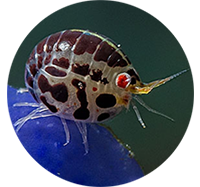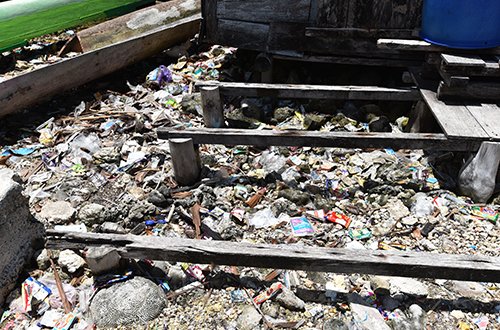Over one million pieces of plastic for every woman, man and child on the planet pollute the oceans, maiming and killing animals, and fish.
In addition, microplastics resulting from plastic breakdown, from health care products and 30% from car tyres. These have a massive negative impact on plankton as well as releasing highly potent greenhouse gases.
By avoiding the use of plastics and reducing the amount you drive, you can help save the oceans. Act! Start today.
 55 plastic shoes collected by 2 people in 10 minutes on a very remote island in West Papua
55 plastic shoes collected by 2 people in 10 minutes on a very remote island in West Papua
Around 300 million tons of plastic is produced per year globally. About 50% is single use. Between 4.8 and 12.7 million metric tons of plastic enter the ocean every year, forming floating layers up to ..... meters thick over thousands of square kilometers. Henderson Island, one or the remotes islands on the planet is a Wold Heritage site, with a population of zero. It is polluted by 38 million pieces of plastic, making it the most polluted place on earth. The Cocos (Keeling) Islands have beaches thick in plastic - 414 million pieces including 977 000 shoes and 373 000 toothbrushes. The 600 inhabitants don't produce that much rubbish. It's brought in by ocean currents that meet around the islands.
Conservative estimates suggest that over 5 trillion pieces of plastic float on the ocean surface - one million pieces for every woman, man and child on the planet. These figures do not include the microplastics!
In the North Pacific there is a current that rotates slowly in a spiral concentrating plasic waste in unbelievable quantities - estimated at 6 kg for every 1 kg plankton. This is called the North Pacific sub-tropical gyre (between California and Hawaii). It is as big as Texas or Turkey. Plastic is not only on the surface. Spam tins have been found at c. 5 000 meters in the Sirena Deep, and plastic bags in the Mariana Trench at 10 898 meters.
When plastic is eaten by an animal, it is not digested and mostly stays in the animals stomach, forever. It takes up space, the more space taken up by plastic, the less space there is for food. In the end the animal will die of starvation, and sometimes of thirst as well. Here are some examples
- Everyone has seen the moving scene of an abatross feeding plastic to it's chick after a long foray at sea.
- Images of of seals with broken up nets tearing into their skin as the seals grow are all too familiar.
- Whales are being washed up on beaches around the world - a Cuviers Beaked Whale in the Philippines had about 44kg of plastic it's stomach and died of starvation and thirst, and again in the Philippines 45 of 61 dead whales in the Davao Gulf died of eating plastic (March 2019). In Norway a whale died with 30 plastic bags (English and Danish labels) in it's stomach (February 2017). A Sperm Whale with about 32kg of plastic was washed up on a Spanish beach (March 2013). Plastic found in the stomachs of Sperm whales washed up in Germany included a 14 meter long shrimp net, a plastic bucket and a plastic car bonnet (March 2016).
- A coelacanth, the living fossil that outlived the dinosaurs was found dead in North Sulawesi, killed by a crisp packet (July 2011). They live at depth of 150 to 240 meters!
- On Lord Howe Island, the once healthy population of Shearwaters is now just surviving because biologists are stomach pumping the chicks to remove up to 40 plastic pieces per chick. If this isn't done, the chicks die of starvation.
UNESCO estimates that 100 000 marine mammals die every year due to plastics.
Microplastics are any particles from 5mm down to a few nanometers. They come both from the breakdown of larger pieces of plastic and from the microbeads that have been used in "health" products since the early 1970's. Domestic washing of a load of 6kg synthetics has been shown to release c. 1.2 million microfibres, most of which pass straight through treatment plants and find their way into our seas. About 30% of all microplastics in the ocean come from the abrasion of car tyres and brake pads. That's about half a million tons of tyre-wear microplastics per year in Europe. So, every time you drive, think about the consequences.
What is not currently so often discussed is that plastics, in particular microplastics, release the greenhouse gasses methane (20 times more damaging than CO2) and ethylene, not only when exposed to sunlight, but once exposed the release continues into the night.The older, small, more cracked and pitted the particles are, the more greenhouse gases they release. The exact contribution of this to global warming is unknown at the moment.
Filter-feeding marine animals concentrate microplastics and their chemical load. Why should we worry? Well, oysters, mussels, clams, cockles etc. are all filter-feeders, so when we eat them, we eat the microplastis they contain. Zooplankton also eats microplastic. Once again if the gut fills with something that is indigestable, it starts to starve. Everything in the food chain dependends on zooplankton. In addition, the microplastic makes the zooplankton faeces lighter, so it doesn't sink so quickly. This impacts the entire carbon balance of the deep oceans.
What can you do to help to reduce the use of plastic? Checkout the advice from Greenpeace.





